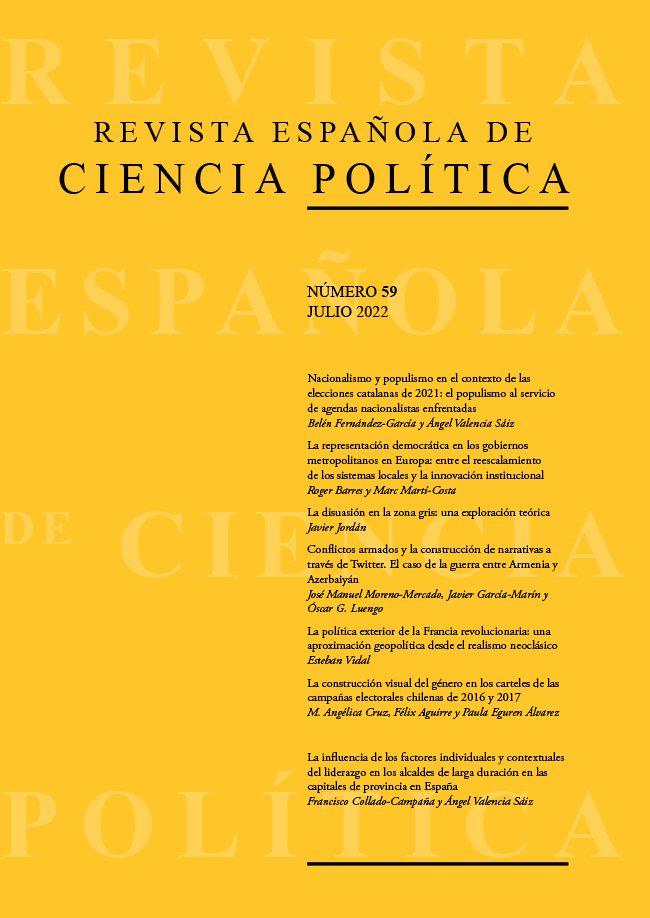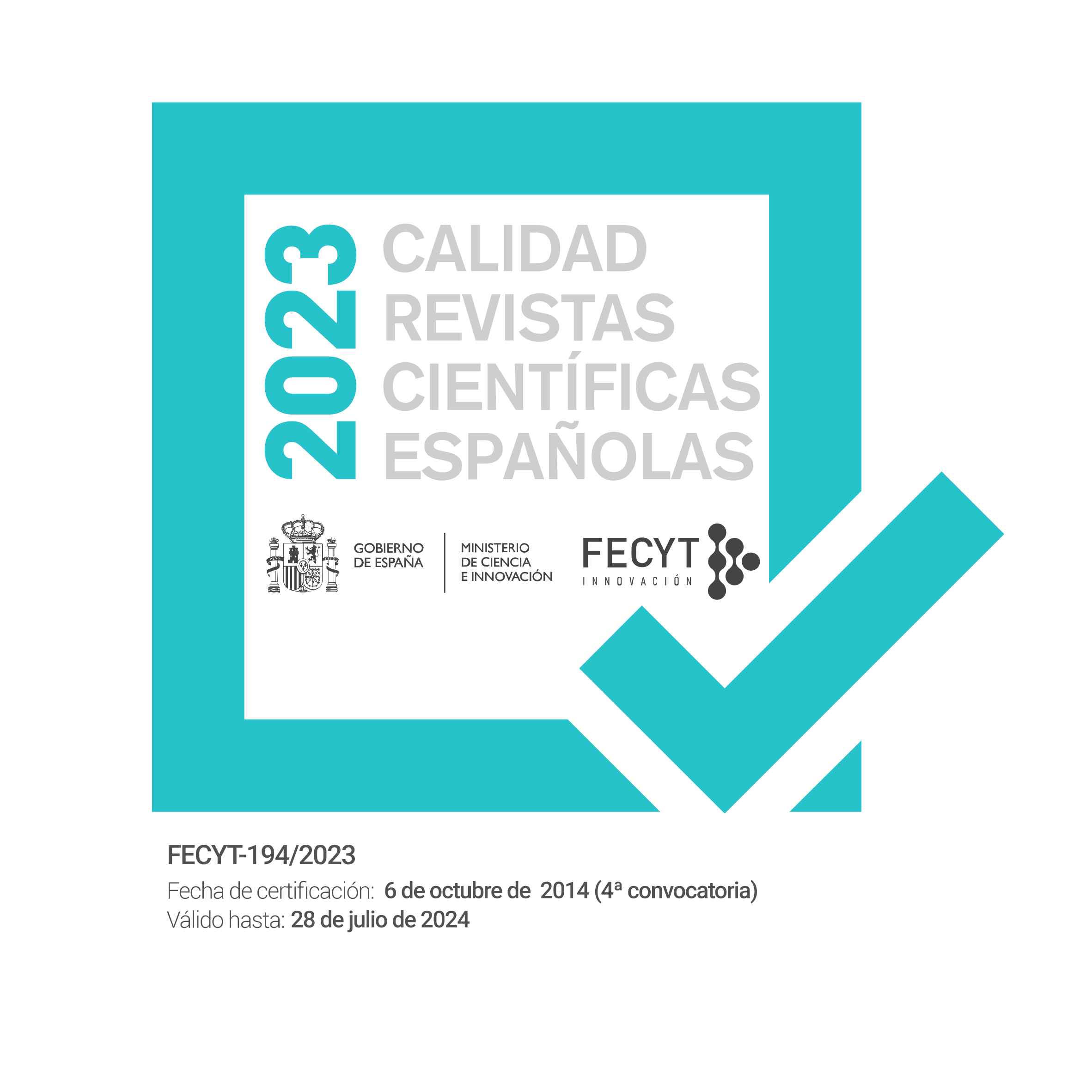La disuasión en la zona gris: una exploración teórica
DOI:
https://doi.org/10.21308/recp.59.03Palabras clave:
disuasión, conflicto en la zona gris, escalada, estrategias híbridas, estabilidad estratégicaResumen
Los estudios sobre disuasión han experimentado cuatro olas. Las tres primeras centradas fundamentalmente en la disuasión nuclear y la cuarta orientada a la disuasión del terrorismo y a los denominados «rogue states». Sin embargo, la disuasión por debajo del umbral de la guerra —es decir, del conflicto en la zona gris— apenas ha recibido atención. Este artículo propone un marco teórico exploratorio para disuadir la escalada dentro de los conflictos en la zona gris. En primer lugar, se presentan algunos principios fundamentales de la teoría de la disuasión aplicables a la escalada en la zona gris a partir de una revisión de la literatura tanto clásica como reciente. A continuación, se estudian el porqué y el cómo de la escalada en la zona gris. Seguidamente, se analizan los retos que plantea a la disuasión en los dos primeros escalones. Por último, el artículo presenta una serie de claves teóricas para la práctica de la disuasión en los conflictos en la zona gris.
Descargas
Citas
Almog, Doron. 2004. «Cumulative deterrence and the war on terrorism», Parameters, 34 (4): 4-19. Disponible en: https://doi.org/10.55540/0031-1723.2222.
Baqués, Josep. 2021. De las guerras híbridas a la zona gris: la metamorfosis de los conflictos en el siglo XXI. Madrid: UNED.
Baylis, John. 2009. «The concept of “tailored deterrence” in the second nuclear age», St Antony’s International Review. 4 (2): 8-23.
Betts, Richard K. 2013. «The lost logic of deterrence», Foreign Affairs, 92 (2): 87-99.
Borger, Julian, Patrick Wintour y Heather Stewart. 2018. «Western allies expel scores of Russian diplomats over Skripal attack». The Guardian, 27-3-2018. Disponible en: https://cutt.ly/FJAIJqq.
Brantly, Aaron F. 2020. «Entanglement in cyberspace: minding the deterrence gap», Democracy and Security, 16 (3): 210-233. Disponible en: https://doi.org/10.1080/17419166.2020.1773807.
Brodie, Bernard. 1959. Strategy in the missile age. Santa Monica, CA: RAND Corporation. Disponible en: https://doi.org/10.1515/9781400875108.
Cohen, Raphael S. y Andrew Radin. 2019. Russia»s hostile measures in Europe understanding the threat. Santa Monica, CA: RAND Corporation.
Echevarria, Antulio J. 2016. Operating in the gray zone: an alternative paradigm for US military strategy. Carlisle, PA: US Army War College Press.
Egozi, Arie. 2021. «Iranian nuke centrifuge plant badly damaged by drones». Breaking Defence, 25-6-2021.
Eisenstadt, Michael. 2020. Operating in the gray zone. Countering Iran»s asymmetric way of war. Washington DC: The Washington Institute for Near East Policy.
European Union. 2016. Shared vision, common action: a stronger Europe. A global strategy for the European Union’s foreign and security policy. Brussels, 29 de junio. Disponible en web: https://europa.eu/globalstrategy/sites/globalstrategy/files/eugs_review_web.pdf.
Fearon, James D. 1994. «Domestic political audiences and the escalation of international disputes», American Political Science Review, 88 (3): 577-592. Disponible en: https://doi.org/10.2307/2944796.
Freedman, Lawrence. 2004. Deterrence. Londres: Polity.
Freedman, Lawrence. 2013. Strategy: a history. Oxford: Oxford University Press.
George, Alexander L. y Richard Smoke. 1974. Deterrence in American foreign policy: theory and practice. Nueva York: Columbia University Press.
Gerasimov, Valery. 2013. «ЦенностьНаукиВПредвидении» [The Value of Science Is in the Foresight: New Challenges Demand Rethinking the Forms and Methods of Carrying out Combat Operations], Voyenno-Promyshlennyy Kurier. Disponible en: https://www.vpk-news.ru/articles/14632.
Giannopoulos, Georgios, Hanna Smith y Marianthi Theocharidou. 2019. The landscape of hybrid threats: a conceptual model. Draft 2.0. Helsinki: European Union and Hybrid Center of Excellence.
Gompert, David C. y Hans Binnendijk. 2016. The power to coerce. Countering adversaries without going to war. Santa Monica, CA: RAND Corporation. Disponible en: https://doi.org/10.7249/RR1000.
Gray, Colin S. 2000. «Deterrence in the 21st century», Comparative Strategy, 19 (3): 255-261. Disponible en: https://doi.org/10.1080/01495930008403211.
Gray, Colin S. 2010. «Gaining compliance: the theory of deterrence and its modern application», Comparative Strategy, 29 (3): 278-283. Disponible en: https://doi.org/10.1080/01495933.2010.492198.
Gray, Colin S. 2012. «Geopolitics and deterrence», Comparative Strategy, 31 (4): 295-321. Disponible en: https://doi.org/10.1080/01495933.2012.711116.
Green, Brendan R. 2020. The revolution that failed: nuclear competition, arms control and the Cold War. Cambridge: Cambridge University Press. Disponible en: https://doi.org/10.1017/9781108779593.
Green, Michael, Kathleen Hicks, Zack Cooper, John Schaus y Jake Douglas. 2017. Countering coercion in maritime Asia: The theory and practice of gray zone deterrence. Washington, DC: Center for Strategic and International Studies.
Halas, Matus. 2019. «Proving a negative: why deterrence does not work in the Baltics», European Security, 28 (4): 431-448. Disponible en: https://doi.org/10.1080/09662839.2019.1637855.
Huth, Paul K. 1997. «Reputations and deterrence: a theoretical and empirical assessment», Security Studies, 7 (1): 72-99. Disponible en: https://doi.org/10.1080/ 09636419708429334.
Jackson, Nicole J. 2019. «Deterrence, resilience and hybrid wars: the case of Canada and NATO», Journal of Military and Strategic Studies, 19 (4): 104-125.
Jervis, Robert. 1978. «Cooperation under the security dilemma», World Politics, 30 (2): 167-214. Disponible en; https://doi.org/10.2307/2009958.
Jervis, Robert. 1979. «Deterrence theory revisited», World Politics, 31 (2): 289-324. Disponible en: https://doi.org/10.2307/2009945.
Jervis, Robert. 1984. The illogic of American nuclear strategy. Ithaca, NY: Cornell University Press.
Jervis, Robert. 1989. The meaning of the nuclear revolution. Nueva York: Cornell University Press.
Kahn, Herman. 2009. On escalation: metaphors and scenarios. New Brunswick, NJ: Transaction Publishers.
Kaufmann, William W. 1954. «The Requirements of deterrence». Center for International Studies. Princeton University. Disponible en: https://findit.library.yale.edu/catalog/digcoll:560733.
Knopf, Jeffrey W. 2010. «The fourth wave in deterrence research», Contemporary Security Policy, 31 (1): 1-33. Disponible en: https://doi.org/10.1080/1352326 1003640819.
Knopf, Jeffrey W. 2012. «Varieties of assurance», Journal of Strategic Studies, 35 (3): 375-399. Disponible en: https://doi.org/10.1080/01402390.2011.643567.
Krepon, Michael. 2015. «Can deterrence ever be stable?», Survival, 57 (3): 111-132. Disponible en: https://doi.org/10.1080/00396338.2015.1046228.
Lantis, Jeffrey S. 2009. «Strategic culture and tailored deterrence: bridging the gap between theory and practice», Contemporary Security Policy, 30 (3): 467-485. Disponible en: https://doi.org/10.1080/13523260903326677.
Liddell Hart, Basil. 1960. Deterrent or defence. Londres: Stevens and Sons.
Lupovici, Amir. 2010. «The emerging fourth wave of deterrence theory. Toward a new research agenda», International Studies Quarterly, 54 (3): 705-732. Disponible en: https://doi.org/10.1111/j.1468-2478.2010.00606.x.
Mallory, King. 2018. New challenges in cross-domain deterrence. Santa Monica, CA: RAND Corporation. Disponible en: https://doi.org/10.7249/PE259.
Marten, Kimberly. 2018. «The puzzle of Russian behavior in Deir Al-Zour». War on the Rocks, 5-7-2018.
Mazarr, Michael J. 2015. Mastering the gray zone: understanding a changing era of conflict. Carlisle, PA: US Army War College Press.
Mazarr, Michael J. 2018. Understanding deterrence. Santa Monica, CA: RAND Corporation. Disponible en: https://doi.org/10.7249/PE295.
Mazarr, Michael J., Joe Cheravitch, Jeffrey W. Hornung y Stephanie Pezard. 2021. What deters and why applying a framework to assess deterrence of gray zone aggression. Santa Monica, CA: RAND Corporation.
McCarthy, Rory. 2006. «Hizbullah leader: we regret the two kidnappings that led to war with Israel», The Guardian, 28-8-2006.
Morgan, Forrest E., Karl P. Mueller, Evan S. Medeiros, Kevin L. Pollpeter y Roger Cliff. 2008. Dangerous thresholds. Managing escalation in the 21st Century. Santa Monica, CA: RAND Corporation.
Morgan, Patrick M. 2003. Deterrence now. Cambridge: Cambridge University Press. Disponible en: https://doi.org/10.1017/CBO9780511491573.
Morgan, Patrick M. 2012. «The state of deterrence in international politics today», Contemporary Security Policy, 33 (1): 85-107. Disponible en: https://doi.org/10.1080/13523260.2012.659589.
Multinational Capability Development Campaign (MCDC). 2019. Countering hybrid warfare. MCDC Countering Hybrid Warfare Project.
Norton, Augustus Richard. 2007. «The role of Hezbollah in Lebanese domestic politics», The International Spectator, 42 (4): 475-491. Disponible en: https://doi.org/10.1080/03932720701722852.
Nováky, Niklas I. M. 2018. «The credibility of European Union military operations’ deterrence postures», International Peacekeeping, 25 (2): 191-216. Disponible en: https://doi.org/10.1080/13533312.2017.1370581.
Payne, Keith B. 2011. «Understanding deterrence», Comparative Strategy, 30 (5): 393-427. Disponible en: https://doi.org/10.1080/01495933.2011.624814.
Press, Daryl G. 2005. Calculating credibility: how leaders assess military threats. Ithaca, NY: Cornell University Press.
Rid, Thomas. 2012. «Deterrence beyond the state: the Israeli experience», Contemporary Security Policy, 33 (1): 124-147. Disponible en: https://doi.org/10.1080/13523260.2012.659593.
Sagan, Scott D. 1994. «The perils of proliferation: organization theory, deterrence theory, and the spread of nuclear weapons», International Security, 18 (4): 66-107. Disponible en: https://doi.org/10.2307/2539178.
Sagan, Scott D. y Kenneth N. Waltz 2003. The spread of nuclear weapons: a debate renewed; with new sections on India and Pakistan, terrorism, and missile defense. Nueva York: Norton.
Schelling, Thomas C. 1980. The strategy of conflict. Cambridge, MA: Harvard University Press.
Schelling, Thomas C. 2008. Arms and influence. New Haven: Yale University Press.
Schweller, Randall L. 2004. «Unanswered threats: a neoclassical realist theory of underbalancing», International Security, 29 (2): 159-201. Disponible en: https://doi.org/10.1162/0162288042879913.
Snyder, Glenn H. 1960. «Deterrence and power», Journal of Conflict Resolution, 4 (2): 163-178. Disponible en: https://doi.org/10.1177/002200276000400201.
Snyder, Glenn H. 1961. Deterrence and defense: toward a theory of national security. Princeton, NJ: Princeton University Press.
Snyder, Jack y Erica Borghard. 2011. «The cost of empty threats: a penny, not a pound», American Political Science Review, 105 (3): 437-546. Disponible en: https://doi.org/10.1017/S000305541100027X.
Stone, John. 2012. «Conventional deterrence and the challenge of credibility», Contemporary Security Policy, 33 (1): 108-123. Disponible en: https://doi.org/10.1080/13523260.2012.659591.
Stratfor. 2021. «The Implications of Renewed U.S.-Iran Violence in Iraq and Syria». Stratfor. Disponible en: https://cutt.ly/PJAKO3y.
Takahashi, Sugio. 2018. «Development of gray-zone deterrence: concept building and lessons from Japan»s experience», The Pacific Review, 31 (6): 787-810. Disponible en: https://doi.org/10.1080/09512748.2018.1513551.
Tang, Shiping. 2005. «Reputation, cult of reputation, and international conflict», Security Studies, 14 (1): 34-62. Disponible en: https://doi.org/10.1080/096364 10591001474.
Tang, Shiping. 2009. «The security dilemma: a conceptual analysis», Security Studies, 18 (3): 587-623. Disponible en: https://doi.org/10.1080/09636410903133050.
Tor, Uri. 2015. «“Cumulative deterrence” as a new paradigm for cyber deterrence», Journal of Strategic Studies. 40 (1-2): 92-117. Disponible en: https://doi.org/10.1080/01402390.2015.1115975.
Trachtenberg, Marc. 2012. «Audience costs: an historical analysis», Security Studies, 21 (1): 3-42. Disponible en: https://doi.org/10.1080/09636412.2012.650590.
UK Ministry of Defence. 2019. «Deterrence: The defence contribution». JDN 1/19. Disponible en: https://cutt.ly/5JAKXZf.
Veebel, Viljar. 2018. «NATO options and dilemmas for deterring Russia in the Baltic States», Defence Studies, 18 (2): 229-251. Disponible en: https://doi.org/10.1080/14702436.2018.1463518.
Waltz, Kenneth. 2010. Theory of international politics. Long Grove, Illinois: Waveland Press.
Williams, Phil. 1983. «Miscalculation, crisis management and the Falklands conflict», The World Today, 39 (4): 144-149. Disponible en: https://doi.org/10.2307/633335.
Wohlstetter, Albert. 2009. «The delicate balance of terror», en Robert Zarate y Henry Sokolski (ed.). Nuclear heuristics: selected writings of Albert and Roberta Wohlstetter. Carlisle, PA: US Army War College.
Publicado
Cómo citar
Número
Sección
Licencia
Derechos de autor 2022 Javier Jordán

Esta obra está bajo una licencia internacional Creative Commons Atribución-NoComercial-SinDerivadas 4.0.






